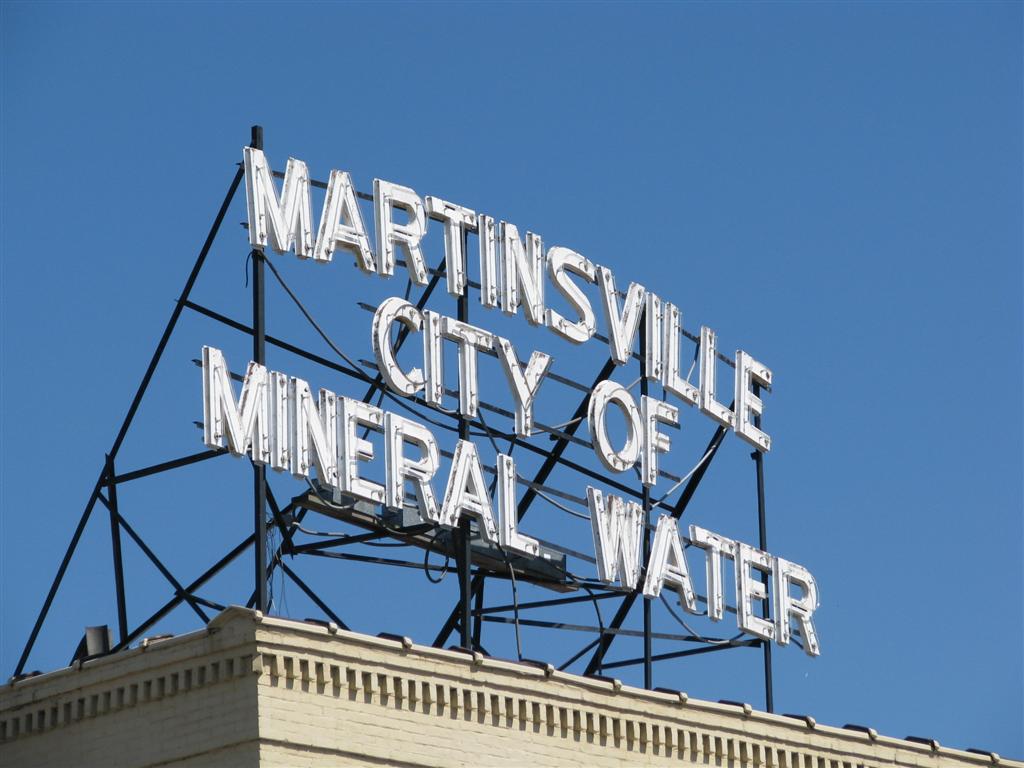"Union Block, northeast corner of Main and Morgan Street, Italianate, 1866. and “MARTINSVILLE CITY OF MINERAL WATER” sign, c. 1930
Occupying nearly a quarter block, this anchor two-story brick building today consists of 6-7 units. The foundation is sandstone block. The front elevation faces south and is painted in four different colors demarcating the individually owned units. The vacant west unit at 10 East Morgan Street is painted tan with mustard yellow cast iron elements. The next unit to the east, 18 East Morgan Street, is painted white; its storefront has been recast using plate glass and glass block. The second story of the next unit at 28 East Morgan Street is buff; the first story has been completely remodeled using new brick. The next and easternmost unit, 36 East Morgan Street, has received a facing of new brick as well as a redesigned storefront of limestone and glass. This last unit actually is made up of one business room in the Union Block and the neighboring building to the east.
The entire second story front facade presents a unified face: 19 arched windows with limestone sills, plinth blocks and keystone are symmetrically placed below semi-circular attic vents. The windows in the first (tan) unit have been reduced and the vents filled. The windows and vents in the next unit (white) are filled. The windows in the third unit (buff) are double hung sash; the upper sash is arched. The attic vents are filled. The windows in the fourth unit (new brick) are double-hung sash with a semi-circular fixed pane above. The attic vents are filled. A limestone belt course is found below the windows.
The west facade reveals two separate but like-designed buildings; the rear portion of the Union Block is a somewhat later addition. Three business units are located in the rear portion; two are currently occupied. In the rear portion, nine arched double-hung windows are found on the second story. There are three decorative wood attic vents. There are two entrances at ground level, each placed in a slightly recessed arched panel. These panels are painted chocolate brown. In the front portion of the west facade at the second story are eight arched double-hung windows identical to those on the front facade. Below them at street level are eight recessed arched panels; they do not appear to originally been windows. On the north wall, along the east-west alley, is the faded remnants of an advertising mural for Cremo Tobacco. About the turn of the century, the southwest corner was altered along with the storefront on East Morgan Street with cast iron posts. This alteration coupled with subsequent neglect has caused a major separation in the brickwork at this corner, critically loosening a keystone and seriously endangering the building.

On the building’s roof at the southwest corner is located an unusual historic resource: a neon sign promoting "MARTINSVILLE CITY OF MINERAL WATER”, c.1930. Advertising the healing properties of Martinsville’s artesian wells, this sign, which was paid for by public donations, attracted visitors to the city’s many sanitariums. It has long been inoperable.[The sign was restored in 2001 and now is operable]
In 1858, Norman T. Cunningham entered the general mercantile business with John Stevens. The business had flourished by 1866 so that Cunningham could erect this anchor commercial block on the northwest corner of the public square. A skilled and successful farmer and merchant, Cunningham owned over 800 acres in Morgan County, laid out two additions to the city of Martinsville and "invested much money in the building enterprise", according to Morgan County historian Charles Blanchard.
During its history, the Union Block was occupied by Cunningham's mercantile until 1888. A second floor room was the first location of the Home Building Association (now Home Bank), the only local financial institution to survive the Depression. With a total of five business rooms, the Union Block housed an early Kroger grocery store (and later an A & P store) and various other retail businesses. About 1910, the east half of the Union Block was converted into Blackstone's Theatre (which much later became the State Theater) and cigar shop and pool hall. The theater entrance was at the rear of an approximate 12-foot wide corridor cut out of the building's solid front. - Historic District Nomination Form